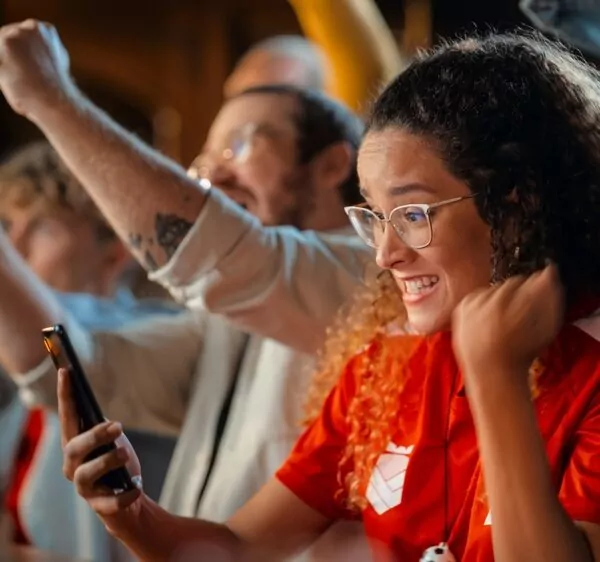Tactics for Better Engagement: RTE and Social Betting in Sports App Design
The sports and sports betting industries are having to rapidly adapt to changing demographics and engagement habits. Cable TV and in-person events are no longer the be-all and end-all for sports fans. Younger generations are forcing the entire industry to rethink their approach — especially for ways to foster real-time engagement (RTE).
This post explores RTE’s role in interactive betting, the impact of social betting on fan engagement, and how these concepts are being implemented in popular sports and fantasy apps.
The Sports Fandom is Changing

According to Morning Consult, The Washington Post, and The New York Times, the sports industry is grappling with Gen Z’s changing consumption habits.
The Morning Consult survey found that 32 percent of Gen Zers watch live sports through authorized streaming services, compared to 28 percent who watch via broadcast or cable TV. YouTube, Instagram, and TikTok are their most popular sports news sources. Nearly half (47 percent) have never watched a professional sporting event in person.
Gen Z’s interest in sports is significantly lower than that of older generations, and their attendance at live games and TV viewership reflect this. The industry is trying to engage Gen Z by modernizing its marketing approach and focusing on digital platforms.
With the legalization of sports betting, there is renewed hope among many in the industry that engagement patterns will change for the better. By gamifying sports with RTE tactics, experts are betting fans feel more connected to the players, teams, and leagues they love.
Betting and fantasy sports apps are taking note, building in components to make real-time engagement possible.
Real-Time Engagement and How it Encourages Interactive Betting
Real-time engagement is the concept of providing fans with a live, interactive experience. It’s about creating a sense of immediacy and connection, allowing fans to feel like they’re part of the action. In the context of sports betting, RTE is a game-changer.
Sports betting platforms incorporating RTE features allow fans to place bets in real time as the action unfolds. Sometimes called micro-betting or in-game betting, it’s all about betting on the next goal scorer in a soccer match, the outcome of a tennis set, or the next touchdown in a football game.
The immediacy of these betting opportunities enhances the excitement and engagement of watching the game, making fans feel more invested in the outcome.
What Is Social Betting, and How Does it Impact Fan Engagement?
Part and parcel with RTE features is a concept known as social betting. Social betting is all about the thrill of a communal experience based on the experience of social media. Users can place bets, track their success, and compare their performance against friends and a wider community.
The impact on fan engagement is significant. Social betting platforms create a sense of community among fans, fostering friendly competition and shared experiences. They also provide a forum for discussion and debate, further deepening engagement with the sport.
Moreover, social betting can make sports betting more accessible and less intimidating for newcomers. The social aspect can provide a supportive environment for learning and engagement, which can be particularly appealing to younger fans, such as Gen Z’ers, who are accustomed to social media interactions.
Social betting has garnered the attention of a wider, less experienced betting audience. Why? Because most platforms don’t require any financial risk. They also allow the user to play for “fun”, use in-game currency, and win prizes without having to risk or invest.
A Few Examples of how Social Betting Works in Sports and Fantasy Apps
Social betting is already a major component within some of the most successful sports apps. Here are just a few ways the most popular apps have integrated it into their experience:
DraftKings:
One of the largest sports betting apps now allows users to compete against friends or the public. Users can create their own leagues, set their own betting stakes, and track their performance on leaderboards.
DraftKings has also integrated DraftKings Social into their app. It’s a way to share bets, comment on other people’s bets, or share content related to fantasy sports and sports betting on their platform. By following friends, users can connect with others and feel a sense of friendly-competition amongst their peers.
Betway Squad:
This social betting platform allows users to create their own betting groups, place bets as a team, and track their group’s performance against others.
BetBull:
BetBull is a sports betting app that combines traditional sports betting with social elements. Users can follow top bettors, see their bets, and choose to copy them. It also offers chat features, allowing users to discuss games and bets with others.
How To Design an App that Encourages Engagement? Focus on Social Betting Features and Other RTE Tactics
There is no doubt the sports industry is undergoing a transformative shift as it adapts to the changing demographics and engagement habits of fans. Traditional modes of sports consumption, such as cable TV and in-person events, need to adapt to a digital world, on-demand streaming, and social betting habits.
As the evolution of sports fandom unfolds, embracing these innovations will be crucial for engaging and captivating the next generation.
How will you include RTE and social betting in your sports app? We’d love to help you build an app for the new generation of sports bettors.




